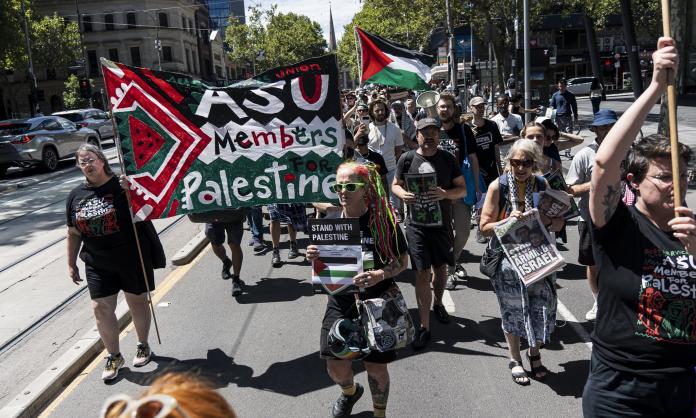Workers’ wages in Australia have stagnated or gone backwards for half a decade, while the super rich have been helping themselves – with both hands.
According to the Australian Financial Review’s annual survey, the richest 200 people in the country increased their total wealth from $176.8 billion in 2013, to a colossal $282.7 billion this year – an increase of 60 percent in just five years. Between 2017 and 2018, their fortunes increased by 21 percent, a total additional wealth of $49 billion.
This money, spent to meet human needs, could transform our cities. A new hospital costs around $2 billion. We could have paid for two dozen of them – in just a single year – if the richest people in Australia were prepared to “make do” with their previous, obscene, level of wealth.
The total federal government spending on residential aged care is $11.4 billion per year. We could have doubled it – and still had billions spare from the Rich 200’s extra cash – if our society’s priorities were about looking after the many, rather than enriching the few.
Corporate profits have surged from $60 billion in 2016 to nearly $90 billion in the past year. But even with profits at record levels, Tax Office data show that a third of large companies pay not one cent in tax. Adani mining, Acer computers, AGC finance, Amcor, American Express, Anglo American Coal, Ansell, Asahi (brands include Schweppes, Spring Valley, Cottees and imported beers), and aged care giant Aveo – these are just a handful of the companies that paid nothing in corporate tax last year, and that’s not even a full list for the letter “A”.
In recent years, public services such as aged care, transport, vocational training and electricity have been turned into cash machines for private owners. The mania for “self-regulation” of these essential services means these companies write their own rules, while we pick up the tab.
The main banking regulator, the Australian Prudential Regulatory Authority, admitted during the banking royal commission that it hasn’t launched a single prosecution against a bank in 10 years. According to investment bank Morgan Stanley, the colossal criminal rip-offs highlighted by the commission will result only in fines, customer remediation and additional regulation worth a maximum of 2.5 percent of the forecast $90 billion in cash profits the banks will enjoy over the next three years.
One rule for the rich, one for the rest of us
While the rich write their own rules and watch their wealth pile up, the trade unions – the most important organisations that working class people have – are facing repression and colossal fines. There’s no “light touch self-regulation” for unions, just an ever-tightening legal noose.
Just in the past three weeks, we’ve seen the Australian Competition and Consumer Commission bring a charge of “cartel behaviour” against the main construction union, the CFMMEU. The Canberra branch of the union had been trying to encourage scaffolding companies to agree on a rate for the job that wouldn’t undercut workers’ wages.
Petroleum giant BP has applied to terminate the enterprise agreement of Australian Workers’ Union members at the giant Kwinana refinery near Perth. This would allow the company to cut wages by up to 60 percent and eliminate longstanding conditions such as the 35-hour week.
The Federal Court has fined 75 construction workers $105,000 for walking off John Holland’s Children’s Hospital building site in Perth to attend a union rally in 2013. John Holland pioneered the legal tactic of getting three workers to sign a rotten but legally binding enterprise agreement that eventually covered thousands of workers – a new way of undercutting established union conditions. The company’s actions were upheld in the courts: workers who stopped work to protest against this wage-cutting technique copped a substantial fine.
The federal government’s Fair Work Ombudsman has threatened fines against workers who walk off the job to attend ACTU Change the Rules rallies.
And the CFMMEU was fined $313,000 for taking industrial action – during a period of legally protected industrial action – against Sydney concrete companies during a successful campaign to win a site allowance across the industry in 2014-15.
There’s a simple reason our rulers try to fine industrial action out of existence: pretty much every decent thing that working class people have has been won by unions taking strike action. The decent wages that generations of workers enjoyed were won by strikes – especially the giant strike wave that peaked in 1974.
In this period, the gap between the richest and the poorest became the smallest ever. Under pressure from a working class prepared to shut down production, a string of important social gains were won, including Medicare (originally Medibank) and free tertiary education.
Further back, the eight-hour day – the idea we should be able to earn a decent wage and still have time for education, recreation and social and political activity – was won by strikes in the 1850s, and has been defended by union action many times since. Nurse-patient ratios were won by Victorian nurses following an epic 50-day strike in 1986. Penalty rates to compensate for anti-social hours, annual leave, sick pay and the five-day week were all won by strike action. The list goes on.
We’re not going to hang on to the gains of the past, or make further advances, unless we return to the militant industrial action that won these gains. The low level of strikes today is the cause of the widely noted wage stagnation in Australia.
For half a decade, the average rate of pay has not increased by even one dollar, once inflation is taken into account. And as economist Greg Jericho pointed out in the Guardian earlier this year: “Because there has also been a shift towards more part time employment over the past four years, which invariably pays less than full time work, combined with low wage growth, the average real earnings of Australian workers has [sic] actually fallen”.
This is the working class’ “reward” for Australia’s 27 years of economic growth, the longest of any advanced economy in history.
We need a class struggle alternative
The ACTU’s Change the Rules campaign is squarely focused on kicking out the Liberals. A recent cross-union delegates’ meeting in Melbourne was presented with a simple three point plan. Step one was return the Labor government in Victoria. Step two was defeat the Liberals federally. And step three seemed to take care of itself: “change the rules!”
In real life, things will not be that simple.
Looking at the long list of broken rules designed to shackle our unions, it’s clear that the ALP is part of the problem. Labor has been at least as culpable as the Liberals in putting together these anti-worker, anti-union rules – and it has only a lukewarm commitment, at best, to changing them.
Bargaining: In the 1970s, unions commonly bargained across entire industries and supply chains. Strong workplaces would strike to win improved wages and conditions, which would then flow through the whole sector.
One key moment in destroying this system came in 1993, when Labor brought in the system of enterprise bargaining. Workers doing the same job, in the same industry (and even employed by the same company, such as Woolworths, through different shelf companies), can have radically different conditions and pay. This Labor “reform” opened the gate to the flood of outsourcing arrangements, now commonly used to cut wages. Today’s Labor Party leadership has made no commitment to reversing this.
Industrial action: In Australia, no strikes are allowed until an enterprise agreement has expired. This is much more restrictive than in other countries, including Britain, where unions can ballot for industrial action at any time (for instance over job cuts), or in the Philippines or the US, where workers have a legal right to strike in protest against “unfair labour practices” (for instance, the sacking of union delegates).
Even after an agreement has expired, Australian workers must jump through legal hoops to go on strike, and even then can have strike action disallowed because of potential “economic damage” to a part of the community – as Sydney rail workers discovered this year.
All of these restrictions are creations of the Labor Party. The prohibition on strikes outside a bargaining period dates from Labor’s 1993 laws. The legal obstacles to taking action are laid down in Labor’s Fair Work Act of 2009. Labor has made no commitment to reversing these restrictive rules.
Solidarity action: Workers in many other countries have the right to take solidarity action. For instance, truck drivers in the US Teamsters union have language in their largest union contract saying they don’t have to cross any picket line. This would be illegal in Australia.
The Liberals outlawed “secondary boycotts” in 1977 – but successive Labor governments have refused even to attempt to do anything to reverse this. The Labor leadership has ruled out changing these laws.
Right of entry: Up to the 1990s, union organisers could enter any work site where their members might be working. The Howard Liberal government’s industrial laws stopped this. Officials had to give 24 hours’ notice. Management could dictate where officials could go on a work site to “consult” with workers and the route they would have to take to get there.
These restrictions were kept in the Labor government’s Fair Work legislation in 2009. Finally, just before losing office in 2013, Labor legislated to give unions access to the lunch room to talk with workers. But unions that insist on accessing workplaces that they cover without giving notice – including the construction unions – face massive fines. Labor has given no commitment to changing these laws back to the pre-WorkChoices norm.
Penalty rates: In the 2016 election, Bill Shorten condemned the Greens for proposing to legislate to protect penalty rates. In the lead-up to the next election, Shorten is at least saying he will reinstate the penalty rates cut over the past couple of years. This is one of very few explicit promises that Labor has made to workers and our unions.
Australian Building and Construction Commission: This anti-union taskforce was established by the Liberals in 2005 to discipline the construction unions by fining them if they continue to take strike action. Labor politicians promised to abolish the ABCC when they won the 2007 election. They lied.
Labor in office simply reduced the ABCC’s budget and scaled back the fines it could impose. When the Liberals were elected in 2013, it was easy for them to increase the budget. They’ve now reinstated the ABCC’s full powers, and the ABCC boasts of the $8 million in fines it has imposed on the CFMMEU since 2016. Labor under Shorten has promised to abolish the ABCC, just like in 2007. We’ll see.
The problem with Labor
This track record is much too consistent to be just coincidence or bad luck. It’s not some unfortunate mistake that Labor behaves in this way. It’s the predictable outcome of its politics. Though Labor is tied to the unions, the party accepts as legitimate the obscene wealth and unelected, unaccountable power of the Rich 200. Labor believes that the workers’ movement must collaborate with ruling class power, rather than challenge it head-on – and ultimately abolish it.
This program of “class collaboration” underpins all the compromises of Labor. It led to the notorious Prices and Incomes Accord of 1983, through which the Hawke-Keating Labor government and the ACTU policed the union movement much more effectively than the conservatives and their industrial police ever could.
They smashed unions such as the Builders Labourers’ Federation and the Pilots’ Federation, which continued to use industrial action to advance their members’ interests. Time after time, this acceptance of ruling class power has led to every Labor government kicking its own supporters in the teeth.
Compounding the problem with Labor is our union leaders’ attitudes to the parliamentary party. We’ve had two all-union delegates meetings in Melbourne this year – and heard not one word from the platform explaining that our movement would have to fight Labor, if it gets elected.
There was not one mention that the “broken rules” are as much Labor’s creation as the Liberals’. The recent delegates’ meeting in Melbourne was 100 percent geared to uncritical electioneering for Labor. We weren’t asked to consider a program of industrial action to extend union rights. There was no space for the debates, discussion and often messy democracy essential to any living, breathing workers’ movement.
Any real union revival, which could – like in the 1970s – win new rights for workers and force concessions out of the ruling class, will depend on widespread and crippling strikes in which workers use our strongest weapon to shut off production and disrupt the system’s “business as usual”.
This would meet fierce opposition from any Labor government – especially the current leader Bill Shorten, who made his career as an Australian Workers’ Union official by cutting deals with employers to lock out more militant unions. There is simply no indication that any section of our existing union leadership is prepared to consistently argue for and prepare for, let alone embark on, such a strategy.
Handing Labor a blank cheque is the failed strategy from the 2007 Your Rights at Work campaign, which unseated the Howard government but failed to win significant reforms. Yet this is the same strategy embedded in today’s Change the Rules campaign. The strategy was a dead end in 2007 and it’s a dead end today. We need something very different to this uncritical cheerleading for Labor if our side is to make real gains.
There is a final problem to be overcome if the workers’ movement is to turn things around. In the past, the reformist, class-collaborationist politics that have always dominated the top levels of Australia’s trade union movement have been challenged by a political tradition of class organisation and class struggle.
The great union revival of the first decade or so of the 20th century was powered by syndicalists – revolutionary unionists. The most famous of these was the Industrial Workers of the World, the first revolutionary organisation with a mass following in Australia. The militants who revived the unions after the catastrophic defeats of the early 1930s were inspired by a communist world view. And the union revival of the late 1960s and early 1970s was intertwined with a renewed radical left that sprang out of the tumultuous, defiant mass movement against the war in Vietnam.
It’s possible that an incoming Labor government would, like the 2007 Rudd-Gillard government, slightly ease the legal pressures on our unions. But this tinkering at the edges is a far cry from the radical changes we need to revive the workers’ movement and challenge the wealth and power of the Rich 200 and their class. History tells us that for changes of that scale, reviving a radical political tradition unafraid of confronting Labor and the Liberals, and the system they both defend, will be essential.











